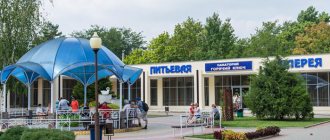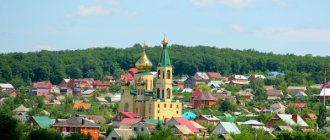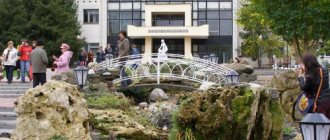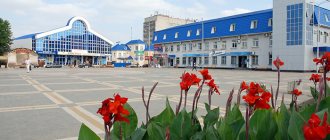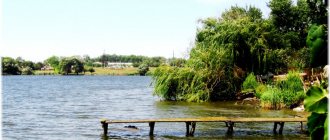There are different names for this park - “Mountain”, “Healing”, “Sanatorium”
The resort park of the city of Goryachy Klyuch is surrounded by greenery, tall trees everywhere create shade and coolness. Despite the fact that the park is located close to the road, there is clean and fresh air. The park contains several beautiful attractions and a mineral water gallery. A separate advantage is that the Resort Park is located just an hour’s drive from Krasnodar.
Conventionally, the park can be divided into two parts - the one on the right is more calm, the left is full of retail outlets, souvenir shops, children's entertainment and is generally more crowded.
Hot key. How to get there
The resort town of Goryachiy Klyuch is located 50 km from Krasnodar and only 60 km from Dzhubga, and therefore from the sea.
The Goryachiy Klyuch Resort Park, also known as the Mountain Park, is a favorite vacation spot for local residents and guests from Krasnodar. Driving time from Krasnodar to here is only 1 hour. Buses and trains also run regularly, so there are no problems with the arrival and departure of nonresident residents. Here you get an excellent dose of the freshest clean air of the foothills of the Caucasus, warm sun, beautiful landscapes and opportunities to walk along forest paths, both equipped and wild. You can start a walk through the Resort Park either from Lenin Street, the central street that smoothly turns into the central alley of the park, or from the M-4 Don highway from the Old Castle Hotel. If you get there by car, it is more convenient from the M-4 highway - there are quite spacious free parking lots on both sides of the road. The parking lot adjacent to the park and the Psekups River is larger and has more space.
Hot key. Hotel Old Castle. Photo from the parking lot
Great Phanagorian (Stalactite) Cave
The Great Phanagorian Cave, in the vicinity of Goryachiy Klyuch, was first described by the Turkish traveler Evliei Celebi in the 17th century. He said that in the central hall of the cave there was a huge bronze statue. Whether it was or not is no longer possible to establish. It is indisputable that the Phanagorian Cave is one of the most mysterious in the Caucasus.
According to legend, this natural tunnel used to stretch for 25 kilometers, right to the Black Sea coast, but then it turned out to be blocked. It is also known that the indigenous population had a special relationship with this cave - it was a sacred place, similar to the legendary Tibetan Shambhala.
During a tour of the Phanagorian Cave.
It is located in the valley of the Ayuk River, 12 km from the village of the same name. The entrance to the cave is round, about one and a half meters in diameter. A ten-meter-long narrow tunnel leads into the central hall. There are four halls in the cave. The total length of the cave passages is about one and a half kilometers. It ends with a double branch. One of the passages leading further is blocked, and the other becomes too narrow for further exploration. A small stream constantly runs along the floor of the cave.
Park in front of the bridge
On the territory next to the hotel, before the bridge, there is a small park area with a fountain, sculptural compositions, green flower arches and plantings. There are places to grab a bite to eat and have a good lunch.
From this side of the river (orographically the left bank) you can clearly see the Cockerel rock against the background of the turquoise water of Psekups - this is a good location for photography.
Rock Cockerel, Hot Spring
Rock Cockerel, Hot Spring
About the history and coat of arms of the city
Before the Caucasian War of the mid-19th century, the Circassian (Adyghe) village of Psyfab (“hot water” in translation) was located on the territory of the city. In the 1860s, in connection with the end of hostilities in the Caucasus, that part of the indigenous population that refused to recognize the power of the Russian Tsar was deported to Turkey. Including residents of the village of Psyfab. In 1864, a balneological resort was founded at local mineral springs by the military department. It included a military hospital, baths and drinking water pump room, and a park.
The village of Goryachiy Klyuch was founded in 1868, but in the 19th century, few people in the Russian Empire knew about this resort. From 1906 to 1920 the settlement was called Alekseevsky Goryachy Klyuch; in 1926 the place was transformed into a village; since 1930 it received the status of a resort village. During the Great Patriotic War, Goryachy Klyuch was occupied by fascist troops for several months. The growing resort village was recognized as a city on November 11, 1965.
Coat of arms of the city of Goryachy Klyuch.
The city's coat of arms symbolizes the favorable natural and climatic conditions of the resort and its mineral springs. On a blue background there is an arch and a tilted amphora pouring out water - all of this is silver. The arch symbolizes the open gate, a symbol of the hospitality of the residents of the resort city. The amphora and the water pouring out of it are a symbol of the source of life and health. In Soviet times, the coat of arms of Goryachiy Klyuch depicted gushing springs, a medical emblem (a bowl and a snake), and a ring with an ear of grain and a gear.
Happy Bridge
From this side of the river, you can only cross the main part of the sanatorium area and the Resort Park via a 70-meter suspension bridge (Bridge of Hope, also known as the Happy Bridge). At night, the bridge and the rock are illuminated, so it’s beautiful not only during the day.
Bridge of Hope (Happy Bridge). Hot key
From the bridge there is a good view of the Psekups River and the Cockerel Rock. The view in a southerly direction (against the flow of the river) is more interesting.
River Psekups. South view
River Psekups.
On the right bank of the river there is a small bathtub with a hydrogen sulfide healing spring. Here in the warm season there are always people who want to improve their health.
Hot tub with hydrogen sulfide source
Psekup dolmens
Throughout the Caucasus, these mysterious monumental structures of ancient people have long been found. More than twenty of them can be found in the valley of the Psekups River. One can only guess about the purpose of the dolmens. Scientists are inclined to conclude that these were either places of worship of ancient prehistoric religions, or funerary mausoleums.
Psekupsky dolmens.
Healing Park
Having crossed into the park area, you can turn right along the paths and climb the Cockerel rock, walk through Dante’s Gorge, go to the Iverskaya Chapel or go deep into the cool forest. But it’s better to first take a walk through the landscaped park area. At first, there were children's attractions, cafes, shooting galleries and other standard park entertainment. The Pillar of Memory, an ancient Adyghe archaeological monument, is very popular. They say that if you rub it and stand next to it for a while, all your cherished wishes will come true. It might be worth a try.)
Memory Pillar
Memory Pillar
At the beginning of the alley there is a descent to the river, where you can rent a catamaran or boat and sail along the river. You won’t be able to swim far, especially in summer, when the water becomes less and in some places the catamaran runs aground even in the middle of the river. But the strand is behind a rock, so there’s plenty of room to swim.
Psekups. Catamarans
Beautiful flower beds, sculptural compositions, and monuments are harmoniously located throughout the resort area.
Approximately in the middle of the alley there is a monumental arch with the inscription at the top “Mountain Park” - it divides the entire territory of the Healing Park into the Lower Park with sanatoriums and a hydropathic clinic and the Mountain Park with Dante’s Gorge, the Cockerel rock, a chapel and a mineral glade.
Arch in Goryachy Klyuch Park
Arch in Goryachy Klyuch Park
Psyfabe Fortress
fortress&&
Presumably, it was on the mountain above the mineral clearing that the ancient fortress of Psyfabe (translated as “warm water”) was located. Until our time, nothing remains of it. There is an unusual small stone structure here, which many take to be the remains of a fortress, but in fact, it is an old water reservoir that has nothing to do with the fortress. However, this building often appears in photographs and is presented as part of the fortress.
fortress&&
The fortress, indeed, was once here, and a legend is associated with it about a beautiful princess, the daughter of a local prince who lived in this fortress, and a villain in love with her, who wooed the princess, but was refused. Then, in revenge, he bewitched the princess, because of which she was covered with terrible disfiguring ulcers. The frightened father turned to the wizard, who advised the princess to take baths with local spring water, and a miraculous healing occurred. The villain, as punishment, was imprisoned underground, where he was forever doomed to light fires and heat huge cauldrons of water, which is why hot springs flow here.
Hot&&
After walking a few more meters, you will come to the so-called Royal Pavilions. In fact, nothing remains of the royal pavilions built in the 19th century, but the modern pavilions still have the same name. The largest gazebo is located at the highest point, the next one is right at the place where the “ridge” of the Cockerel rock or Salvation rock is located.
Hot&&
Here once stood a gazebo, built for the arrival of Grand Duke Mikhail Nikolaevich (brother of Emperor Alexander II) in 1864, but under the influence of the river, part of the rock collapsed, and with it the gazebo, and at the site of the collapse a “ridge” formed - almost vertical part of the rock.
Hydrotherapy and drinking gallery
Immediately behind the arch, in the Lower Park, there is a hydropathic clinic, and opposite it is the Drinking Gallery. Entrance to the gallery is free - here you can drink and take with you mineral water from different sources and with different tastes. If you don’t have a container with you, you can immediately buy a glass or bottle. Also in the Drinking Gallery building you can improve your health with herbal tea and oxygen cocktail.
Hot key. Hydrotherapy
Mineral glade
If you turn right from the pillar (from the side where the inscription is), you will follow the path towards Mineral Glade. This is a kind of “heart” of the park. Abadzekhskaya Mountain rises above the clearing. Here and there on the hills you can see images of white birds - or swans, or cranes. Perhaps this is connected with some ancient legend, but, unfortunately, I don’t know which one. The places are very beautiful, however, the overall impression is spoiled by the numerous “autographs” left by modern savages.
Hot&&
The mineral clearing is a large rectangular area artificially excavated from the rock. It is not by chance that the glade is called this way, since it was here that the Psekup mineral waters came to the surface - the main treasure of these places.
Hot&&
For a long time, this place was not well-maintained, but the local tribes who lived here (the ancestors of the Circassians), and then pilgrims, still made their way to the springs for healing water. Today everything here is equipped and improved, but water from the sources no longer reaches the surface - it is diverted through special pipes to the drinking gallery.
Hot&&
The glade is located among the hills, so it is very quiet and peaceful here, in addition, there are several interesting objects located on it. The first is an obelisk standing in the very center of the site, dedicated to... mineral water of the resort. Yes, yes, it is considered the only monument in the world in honor of the mineral waters that healed many people, giving them strength, health and longevity, as well as in honor of “all those who worked to create the resort” (as it is written on the monument itself). The monument was erected in this place in honor of the 50th anniversary of the founding of the resort, in 1914.
Hot&&
The healing spring of St. Panteleimon is also located here. The water in the source is saturated with iron, so it has a specific taste - as if you are drinking from rusty dishes, a very unpleasant taste of rust remains in your mouth. The water flows very slowly, so it takes a lot of time to fill the bottle, and you risk having a long line behind you. But there is no point in putting this water into a bottle, since it very quickly loses its properties - the iron precipitates after just a few minutes. Therefore, it is better to come up with a glass and take a few sips, and also wash your face. This water is believed to have a rejuvenating effect. You can place a candle nearby.
Hot&&
Hot&&
Hot&&
In the mineral clearing there is an interesting chapel, very small, and as if it had grown out of a rock. This is the chapel of the Iveron Mother of God; it was erected here in the 19th century. Its internal part is a small grotto or cave carved into the Abdzekh rock, to which is adjacent a blue extension with a turret. Nearby there is a small recess in the form of a stone arch, reminiscent of the fact that there used to be another spring here - the Iversky Spring. the source was here back in the 20s of the last century, but after the shifts of mountain layers that occurred here, the source disappeared.
Hot&&
Sanatorium Foothills of the Caucasus
After the Drinking Gallery, the green park alley continues and here is the Caucasus Foothills sanatorium, and behind it is the recognizable arch with a jug, symbolizing the city. Behind the arch begins the alley of a thousand pines (Pitsunda pine), which turns into Lenin Street.
Sanatorium "Caucasus Foothills". Hot key
Dante's Gorge. Hot key
If you turn right after the Bridge of Hope, you can get into Dante’s Gorge, located at the foot of the Abadzekh Key Mountain.
The gorge is a natural monument, but it was not without human hands, which ennobled it, cut steps and cleared streams. Local residents gave the name to the gorge in memory of the famous playwright of the Renaissance, Dante Alighieri. In The Divine Comedy, the author describes the hero’s wanderings through the Kingdom of the Dead. The gorge resembles the structure of the World described in Dante's Divine Comedy. The lower part of the gorge is a dark and eternally damp Hell, and the upper part is Paradise - it’s so bright, light and beautiful here. The picturesque views of Dante's Gorge are very attractive to tourists.
Iveron Chapel
At the foot of the Abadzekh Key Mountain, near the entrance to Dante’s Gorge, the Iverskaya Chapel is located. Its full name is the chapel in honor of the Iveron Icon of the Mother of God. This building appeared in the second half of the 19th century. The place for the construction of the chapel was not chosen by chance. Since ancient times, there has been a spring with healing mineral water.
Iverskaya Chapel. Hot Spring Iverskaya Chapel
Forest trails
Also in the park there are a large number of paths going up to the Cockerel rock, Abadzekh mountain, into the forest zone, walking along which is a pleasure. From here you can also walk to the Mirror rock and the Devil's Mouth waterfall (Psechiako).
And if after a walk along Goryachiy Klyuch you suddenly want to go to the sea, then it is only 60 km from here. Along the way, you will cross a pass through the Main Caucasus Range with beautiful views and get to the nearest settlement on the sea - Dzhubga.
GKH. Pass
Dzhubga. Mount Hedgehog
